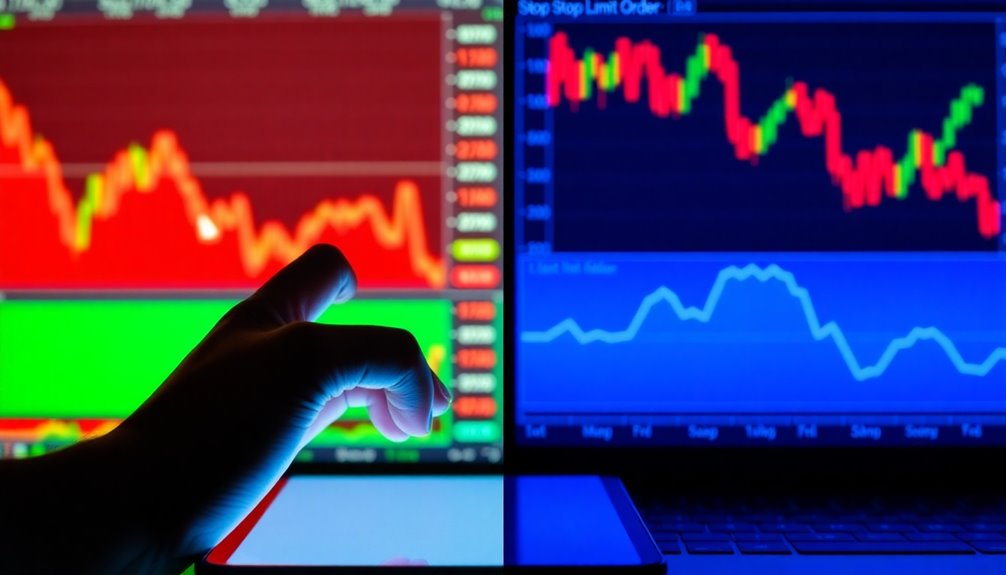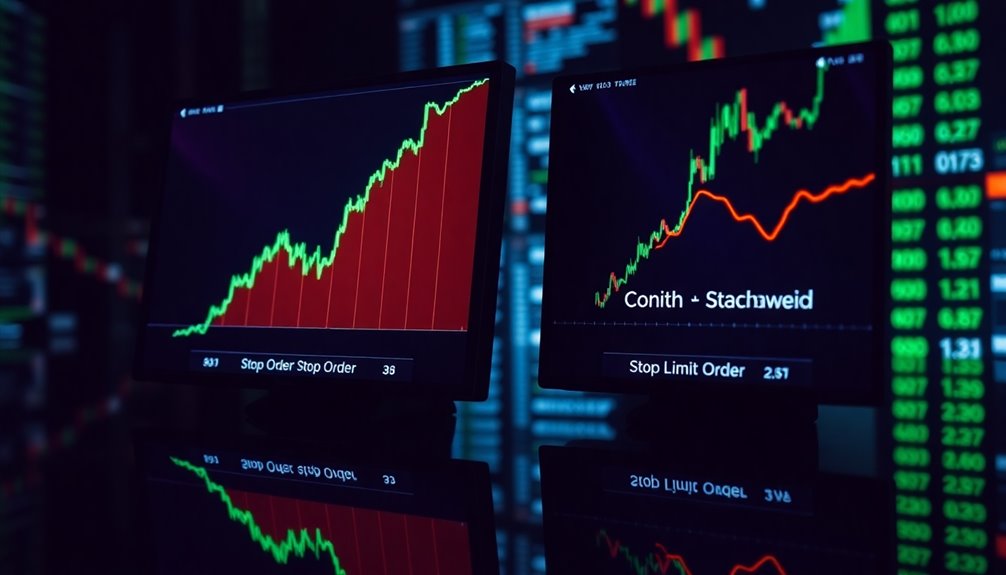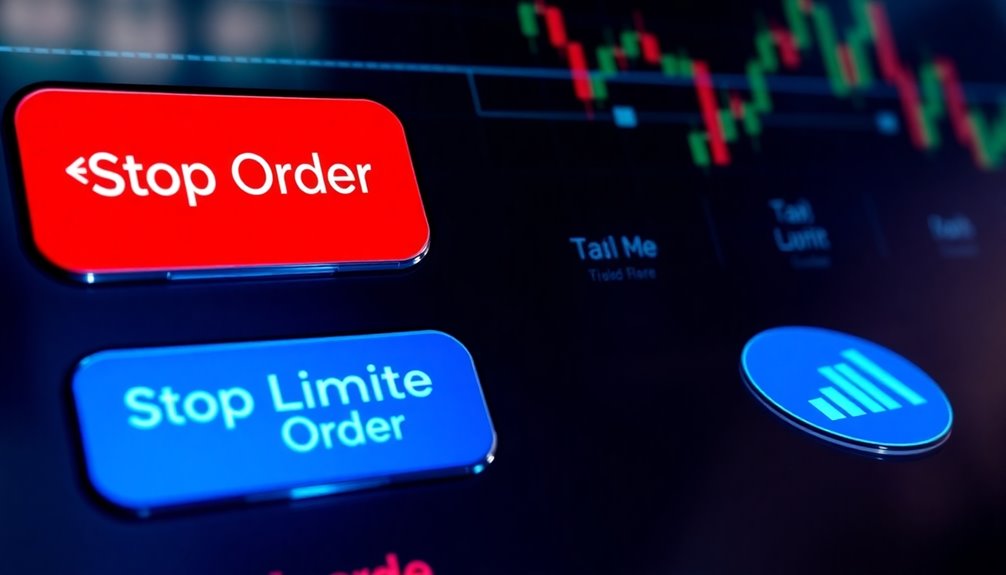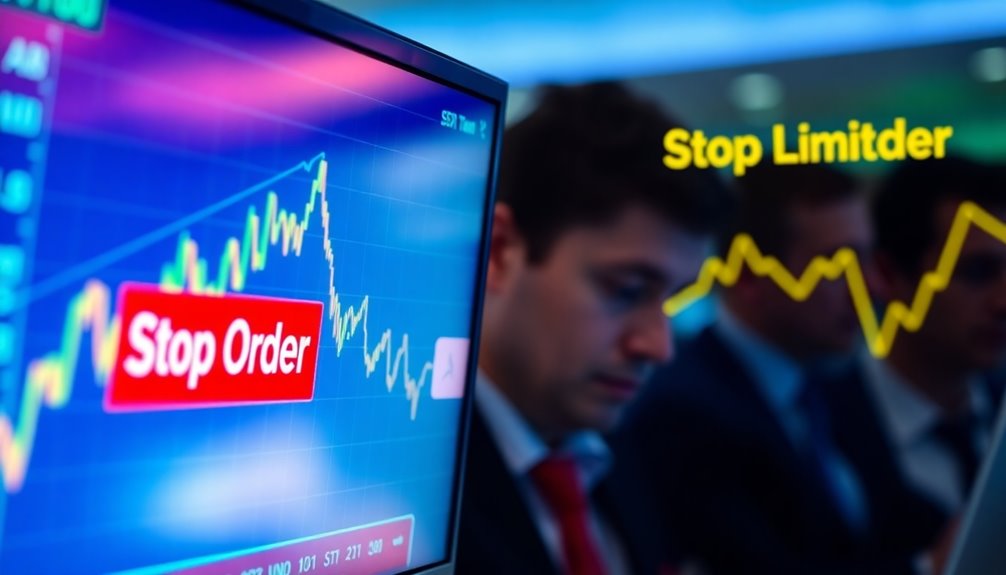In crypto trading, stop orders and stop-limit orders serve different purposes. A stop order triggers a market order once a specific price is reached, ideal for automatic trade execution during volatility but can result in slippage. On the other hand, a stop-limit order activates at a set stop price but converts to a limit order, giving you control over the execution price, although it may leave orders unfilled in fast markets. Choosing the right order type depends on your risk management strategy and market conditions. Discover more about these tools and how they can enhance your trading strategy.
Key Takeaways
- Stop orders execute at market price once the stop price is hit, while stop-limit orders convert to limit orders at the specified price.
- Stop orders are effective for automated trades and risk management during volatility, but may incur slippage.
- Stop-limit orders provide greater control over execution prices, reducing slippage risk but may remain unfilled in fast markets.
- Properly setting stop prices requires market analysis, as effective execution depends on current volatility and liquidity conditions.
- Both order types are crucial for risk management, with stop orders protecting against declines and stop-limit orders facilitating precise entry points.
Order Types Overview

When you're diving into crypto trading, understanding the different order types is essential for effective strategy implementation.
Two key order types are stop orders and stop-limit orders. A stop order becomes a market order once the specified stop price is reached, helping you limit losses or lock in profits. However, be cautious of slippage, as it executes at the best available market price. This makes understanding order types crucial for effective trading strategies.
On the other hand, stop-limit orders require both a stop price and a limit price, allowing you more control over the execution price. While stop orders suit volatile markets for quick action, stop-limit orders excel in scenarios where price precision is crucial.
Grasping these distinctions can enhance your trading strategies significantly.
Order Types Explained

Understanding order types in crypto trading is crucial for executing effective strategies, as each type serves a distinct purpose in managing trades.
Stop orders are designed to limit losses or lock in profits when the asset reaches a specified stop price. Once triggered, they convert to market orders, helping you manage risks in volatile markets.
On the other hand, stop limit orders combine a stop order with a limit order. After the stop price is reached, it triggers a limit order, ensuring you have more control over the execution price. This is particularly beneficial because stop limit orders provide more control over purchase/sale prices compared to standard stop orders.
While stop orders provide quick market access, stop limit orders help avoid slippage, offering precision.
Choosing the right order type depends on your trading goals and risk tolerance.
Order Execution Mechanics Explained

Order execution mechanics play a vital role in how effectively you can manage your trades in crypto markets.
When you use stop orders, they trigger when the market price hits your specified stop price, turning into market orders that execute at the best available price. While execution is guaranteed, the actual price may differ due to market volatility, leading to slippage. This means that execution guarantees differ between stop-loss and stop-limit orders, affecting how you might approach risk management.
In contrast, stop-limit orders give you more control. They activate when the market reaches the stop price and convert to limit orders that only execute at your set price or better. However, if the market doesn't reach your limit, your order may go unfilled, potentially causing missed opportunities.
Understanding these mechanics can significantly impact your trading strategies.
Pros and Cons

While both stop orders and stop limit orders serve crucial roles in crypto trading, each has its own set of advantages and disadvantages that can significantly impact your strategy.
Stop orders excel in risk management by limiting losses and automating trades, allowing you to capture breakouts without constant monitoring. However, their susceptibility to price volatility and false triggers can lead to unwanted trades. Additionally, stop orders may experience price slippage during periods of high market volatility, resulting in execution at less favorable prices.
On the other hand, stop limit orders offer precise control over execution prices and reduce slippage. Yet, they can leave you with unfilled orders if the market moves too quickly.
Ultimately, balancing these pros and cons is essential to shaping your trading approach and achieving your financial goals.
Stop Orders vs. Stop Limits

When deciding between stop orders and stop limit orders in crypto trading, it's essential to grasp how each functions and the unique benefits they offer.
Stop orders activate when the asset price hits a specified stop price, turning into a market order. This means it'll execute at the best available price, which mightn't be ideal due to market fluctuations. Additionally, stop and limit orders play a crucial role in effective risk management by allowing traders to automate their strategies.
On the other hand, stop limit orders are triggered at the stop price but convert into a limit order, executing only at your set limit price or better. This gives you more control over execution prices, reducing the risk of unfavorable trades.
Understanding these differences can help you choose the right strategy for your trading goals.
Market Volatility Impacts Execution

Market volatility significantly influences how orders are executed, impacting your trading outcomes.
With stop orders, you might find them triggering at unfavorable prices due to sudden price swings, leading to unwanted losses or missed gains. Intraday volatility can unnecessarily activate these orders, causing you to exit positions prematurely.
On the other hand, stop-limit orders trigger as limit orders once the stop price is hit, giving you more control over execution prices. However, high volatility can prevent your limit price from being reached, leaving your positions vulnerable. Stop orders are particularly useful for managing risk in volatile markets, allowing traders to establish predefined stop-loss levels based on analysis.
To navigate this, adjust your stop levels based on current volatility and historical data, ensuring you optimize your risk-reward ratios while mitigating slippage and market gaps.
Emergence of Algorithmic Trading

As traders seek to enhance their strategies, the emergence of algorithmic trading has transformed the landscape of crypto trading. By utilizing computer programs to execute trades based on predefined instructions, you can capitalize on market opportunities with precision. This approach strips emotions from trading, ensuring efficient execution at optimal prices. With low latency and the ability to monitor multiple market conditions simultaneously, algorithmic trading reduces transaction costs while minimizing human error. Furthermore, employing algorithms allows for the implementation of backtesting capability, validating trading strategies against historical data to enhance performance.
However, you should be aware of potential pitfalls, including dependence on technology and vulnerability to market disruptions. To successfully implement algorithmic trading, you'll need coding skills, a solid understanding of financial markets, and a reliable network connection to adapt to ever-changing market dynamics.
Use Alerts for Price Changes

Using price alerts is a smart way to stay on top of market movements in crypto trading. You can set up alerts on platforms like Coinbase, altFINS, and CoinCodex to notify you of price changes. Customize your alerts based on specific price levels, percentage changes, or technical indicators like MACD and RSI. Choose from simple price alerts or more complex ones that track chart patterns. Additionally, these alerts can help you keep users updated on market trends and changes, enhancing your ability to make informed decisions. You'll have full control over your alerts, allowing you to enable, disable, or delete them as needed. By integrating alerts with your trading strategies, you can monitor key price levels and automate your trades, ensuring you never miss an opportunity in the fast-paced crypto market.
Frequently Asked Questions
Can Stop Orders Be Used for Trading Cryptocurrencies on All Exchanges?
Yes, you can use stop orders for trading cryptocurrencies on most exchanges.
Major platforms like Binance, Coinbase Pro, and Kraken support them, allowing you to manage your trades effectively.
However, not every exchange offers the same variety of stop orders, so it's essential to check the specific features available.
Are Stop Orders Suitable for Long-Term Investment Strategies?
Stop orders aren't ideal for long-term investment strategies. While they help manage risk in the short term, they can trigger due to temporary price swings, leading you to exit positions prematurely.
If you're focused on long-term goals, you might prefer strategies that allow for patience, like stop-limit orders or trailing stops. These options provide better control over execution prices and help you ride out market fluctuations without being forced to sell too soon.
How Do Market Conditions Affect Stop Limit Order Execution?
Ah, market conditions—the fickle friend of traders everywhere.
When you place a stop-limit order, you're essentially trusting the market to behave, which is like expecting a cat to fetch. If prices swing wildly, your order mightn't get executed, leaving you in the lurch.
Gaps and slippage can turn your carefully planned strategy into a chaotic mess.
Can I Cancel a Stop Order After It Has Been Placed?
Yes, you can cancel a stop order after it's been placed, as long as it hasn't been filled.
To do this, navigate to the 'Trading' or 'Advanced Trade' section of your platform and find 'All Orders' or 'Orders'.
Identify your stop order and select the 'Cancel' option next to it.
Do Stop Orders Incur Additional Fees on Trading Platforms?
Stop orders don't usually incur additional fees on trading platforms.
You'll pay the standard trading fees that apply to regular trades, like maker and taker fees.
It's essential to check your specific exchange's fee structure, as fees can vary.
However, when executing a stop order, you won't face extra charges beyond those standard fees, making it a cost-effective way to manage your trades.
Conclusion
In crypto trading, understanding the difference between stop orders and stop limit orders can feel like navigating a maze. When you choose the right order type, you're not just protecting your investment; you're steering your ship through stormy seas. Just like a sailor adjusts their sail to catch the wind, you can optimize your strategy to harness market movements. Stay alert to price changes, and you'll be ready to set sail toward your trading goals with confidence.









